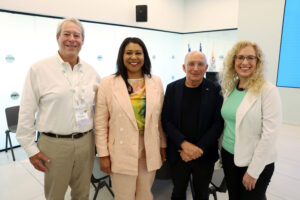SAN FRANCISCO (Press Release) — Shared insights on urban development and downtown revitalization were among the notable takeaways from the San Francisco-Haifa Sister City Delegation’s recent visit to University of Haifa.

In May, University of Haifa welcomed San Francisco Mayor London Breed and 30 other delegates to its campus, as part of their broader visit to Israel marking the 50th anniversary of the San Francisco-Haifa sister city relationship, organized by the Jewish Community Relations Council Bay Area.
Bob Tandler, Chair of the San Francisco-Haifa Sister City Committee, described the architecture of the campus as “very striking and notable,” particularly “the vertical campus in a 30-story building, minimizing the footprint of the campus on Mount Carmel, and the physical plant that has been created in the industrial area and the repurposing of those buildings.”
“This in and of itself is remarkable and very relevant to San Francisco from the context of our thinking, that one of the reasons for focusing on University of Haifa is the ability to repurpose a high-rise — what otherwise might have been an office building — to a vertical campus,” Tandler said. “We think that’s just an incredible opportunity for downtown San Francisco and very relevant to opportunities here.”
It is therefore hardly a coincidence that in the 1980s, University of Haifa President Ron Robin wrote a thesis titled “Signs of Change: urban iconographies in San Francisco, 1880-1915,” while earning his PhD in modern U.S. history at University of California, Berkeley.
The University’s new Lorry I. Lokey City Campus is the academic pillar of the city’s urban renewal project and a cornerstone of its revitalized high-tech center. Consisting of five buildings located throughout the Port of Haifa and the city’s downtown area, the pioneering campus enables University of Haifa scientists to advance their cutting-edge research activities in a wide range of emerging fields, including digital health, artificial intelligence, robotics, and big-data visualization and analytics. The campus also represents a central component of the University’s broader vision and strategic approach as a multi-campus institution with locations around Haifa and throughout northern Israel, easing access for students and adding vitality to its city and region, while allowing a wide range of ideas and activities to flourish in a diverse community.
Dr. Inbal Rivlin, an urban development expert at University of Haifa, gave a presentation to the Bay Area visitors regarding the University’s efforts to revitalize downtown Haifa. Her comments were notable in terms of “what the University was able to accomplish in partnership with the Haifa Municipality for the underused portions of the city’s waterfront, and transforming that neighborhood into a university campus with the housing and retail infrastructure to support a community. It is, again, a terrific opportunity for San Francisco. There are parallels and take-home value that can be discerned from that experience.”
The visitors also listened to an overview of student projects in the city of Haifa from Dr. Yael Granot-Bein, director of the school’s Social Engagement Unit. The unit helps position the University as a living laboratory that pioneers a model for shared society in Israel’s most diverse major city. Arabs comprise 45% of the school’s undergraduate student body. The institution also plays a key role in creating the country’s middle class, as 47% of its undergraduates are in the first
generation of their family to enroll in higher education. Moreover, 84% of its students are from the northern Israeli periphery, positioning the school as an educational, economic, and social anchor in that region.
“You can’t have a meeting in Haifa without Jewish-Arab coexistence being covered,” said Tandler, who noted “an incredible program has been initiated to bring in high school students for a baccalaureate experience at the University, engaging them in all the diversity and community that represents greater Haifa and all of Israel.”
While the San Francisco-Haifa sister city relationship is currently the only partnership of its kind between the Bay Area and Israel, Tandler said his committee has a vision for expanded ties.
“We see Haifa and San Francisco as our ports of entry, and the greater Bay Area and all of Israel as our opportunity,” he said.